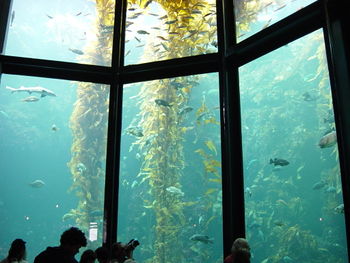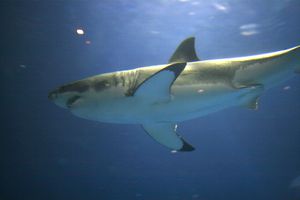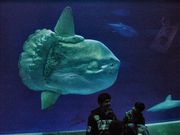Monterey Bay Aquarium
|
||||||||||||||||

10 meter giant kelp forest aquarium
|
||||||||||||||||
|
Front entrance of the Aquarium
|
||||||||||||||||
The Monterey Bay Aquarium (or MBA, founded 1984) is located on the site of a former sardine cannery on Cannery Row on the Pacific Ocean shoreline in Monterey, California. It has an annual attendance of 1.8 million and holds 35,000 plants and animals representing 623 species. The aquarium benefits by a high circulation of ocean water which is obtained through pipes which pump it in from Monterey Bay.
Among the aquarium's numerous exhibits, two are of particular note: The centerpiece of the Ocean's Edge Wing is a 10 meter (33-foot) high 1.3 million liter (1/3 million gallon) tank for viewing California coastal marine life. In this tank, the aquarium was the first in the world to grow live California Giant Kelp using a wave machine at the top of the tank (water movement is a necessary precondition for keeping Giant Kelp, which absorbs nutrients from surrounding water and requires turbidity), allowing sunlight in through the open tank top, and circulation of raw seawater from the Bay. The second exhibit of note is a 4.5 million liter (1.2 million gallon) tank in the Outer Bay Wing which features one of the world's largest single-paned windows (crafted by a Japanese company, the window is actually five panes seamlessly glued together through a proprietary process).[1]
Sealife on exhibit includes stingrays, jellyfish, sea otters, and numerous other native marine species, which can be viewed above and below the waterline. For displaying jellyfish, the MBA uses an aquarium called a Kreisel tank which creates a circular flow to support and suspend the jellies. Visitors are able to inspect the creatures of the kelp forest at several levels in the building. The aquarium does not house mammals other than otters.
Contents |
History
The aquarium occupies land at the end of today's Cannery Row (once Ocean View Avenue) in Monterey, at the site of the Hovden Cannery, a sardine cannery which helped to define the character of Monterey from the time it was built in 1916, to the day when it was the last cannery on the Row to close in 1973, after sardine fishing collapsed. This building was dismantled in 1980, but beginning in 2002 the Monterey Bay Aquarium has blown the original Hovden cannery steam whistle at noon each day to commemorate it. [2]
The aquarium's original building was designed by the architectural firm Esherick Homsey Dodge & Davis and opened on 20 October 1984. The aquarium's mission is "to inspire conservation of the oceans." The aquarium's initial financial backing was provided by David Packard, co-founder of Hewlett-Packard. Packard, an avid blacksmith, personally designed and created several exhibit elements for the aquarium at his forge in Big Sur, including the wave machines in the Kelp Forest and aviary. His daughter, the marine biologist Julie Packard, is currently Executive Director of the aquarium.
Basic design
The basic design of the aquarium pumps 2000 gallons/minute of Monterey Bay ocean water, night and day, through the more than 100 exhibit tanks. During the day the water is filtered for viewing clarity. During the night, raw (unfiltered) seawater is pumped through exhibits, bringing in food in the form of plankton. Waste ocean water from the aquarium is returned to the Bay. This design makes the aquarium ecologically essentially part of the ocean in the Bay, and allows the culture of organisms such as Giant Kelp which are not suitable for ordinary saltwater aquariums.
Newer exhibits
In March 2010, the Aquarium opened a new special exhibition, “Hot Pink Flamingos: Stories of Hope in a Changing Sea,” providing a perspective on global climate change by viewing potential impacts on tropical wading birds, green sea turtles, coral reef creatures, jellies, and Magellanic penguins. In April 2010 it opened “The Secret Lives of Seahorses,” which includes more than 15 species of seahorses, sea dragons, pipehorses and pipefish and shares stories about the threats they face in the wild.
In January 1996, the aquarium opened the new Outer Bay wing to provide exhibits covering the open-water ecology of Monterey's Outer Bay. Besides the above-mentioned million-gallon tank, another of the new exhibits included a school of 3000 anchovies (a fish that was once the foundation of Monterey's economy), swimming against the endless current of a toroidal tank.

Beginning in September 2004, the Outer Bay exhibit was the home to the first great white shark ever successfully kept on exhibit. The shark was at the aquarium for 198 days (the previous record was 16 days). The shark was released on 31 March 2005 after she bit two soupfin sharks in the exhibit, both of which later died. The aquarium staff believe the shark may have been acting to defend territory as she didn't actually eat either of the sharks. On the evening of August 31, 2006 the aquarium introduced a second shark to the Outer bay exhibit. The juvenile male was caught outside Santa Monica Bay on August 17[3] and was released on January 16, 2007. The shark had grown from an initial length of 5-foot-8 and 103 pounds when it arrived on August 31, 2006 to 6-foot-5 and 171 pounds on release. Data from this second white shark was transmitted back to aquarium staff from a pop-off satellite tag after 90 days. For the third time since 2004, the aquarium had a young white shark in the Outer Bay exhibit in 2007/2008. He arrived on August 28, 2007 and was released on February 5, 2008. Like the first shark in 2004, he was caught accidentally in commercial fishing gear. Like the second shark in 2006, he was a young male: just 4-feet, 9-inches long and weighing 67 ½ pounds. As with both of the previous young white sharks, he was kept in an ocean holding pen off Malibu in Southern California until he could be observed feeding and navigating well in the confines of the pen. A fourth great white shark, a young female, was kept in August/September 2008; the fast release being due to its unwillingness to feed.[4] From late August 2009, a young female was again featured in the Outer Bay exhibit and reportedly did well.[5] It was successfully released to the wild in early November 2009.[4]
In March 2000, the aquarium opened a penguin exhibit as part of its Splash Zone family galleries, to complement the already popular sea otter exhibit. The aquarium hosted 19 penguins from the Aquarium of the Americas in New Orleans along with two sea otters after that aquarium was badly damaged by Hurricane Katrina.
Marine research
The Monterey Bay Aquarium maintains a close relationship with the Monterey Bay Aquarium Research Institute (MBARI). MBARI is located in Moss Landing, California, at the head of the submarine Monterey Canyon. It is renowned worldwide for its research on deep-sea marine life and other programs in marine biology.[6] Monterey Bay is located within the Monterey Bay National Marine Sanctuary (MBNMS) a Federally-protected marine area (the equivalent of a saltwater national park) off California's central coast. Many of the visitors to the aquarium are families who bring their children, particularly on the weekends. The aquarium is also home to Seafood Watch, which publishes consumer guides for sustainable seafood purchasing.
Later in 2010, the aquarium received flamingos.
Funding
The Monterey Bay Aquarium was endowed initially with a personal gift from David and Lucile Packard, with the vision that the aquarium would be self-supporting after it opened. The David and Lucile Packard Foundation, other foundations and individuals support some programs of the aquarium. Operating costs are largely covered by visitor admission, as well as by special events and membership dues.[7] The aquarium is organized into three institutions: Monterey Bay Aquarium Foundation, the Support Services, which manages some aquarium-owned property, and the independent Research Institute, which operates three ocean-going research vessels.
Cultural references
The Aquarium appeared in the 1986 film Star Trek IV: The Voyage Home, where it appeared as the Cetacean Institute in Sausalito. The main aquarium was overlaid with special effects to appear to be the tank home of two humpback whales. The film stirred up controversy when people who had come to see the whales were infuriated to learn there was no such exhibit.
In the film, Lemony Snicket's A Series of Unfortunate Events, a character named Stephano is mentioned working with sea snakes at this aquarium; however the real aquarium doesn't have sea snakes.
The aquarium sits next to invertebrate marine biologist Ed Ricketts' home and lab (Pacific Biological Laboratories), which still stand. Ricketts is famous as the "Doc" of John Steinbeck's Cannery Row. The aquarium itself contains a display of Ricketts items, including some of his personal library. The shop also sells a section of Monterey and Steinbeck books.
Marlene the otter from The Penguins of Madagascar was moved to the New York city zoo from The Monterey Bay Aqarium, according to the creators of the show.
Gallery
|
Front entrance of the aquarium |
 A surface supplied diver interacts with viewers while feeding the fish |
 Schooling fish in the Outer Bay exhibit. |
 Exhibit allowing visitors to handle intertidal animals |
 There are many special exhibits presented — such as these Spotted Jellies. (Mastigias papua) |
 Spotted Jellyfish (Mastigias papua) at the Monterey Bay Aquarium. |
 Flower Hat Jellyfish (Olindias formosa) another beautiful creature in the Jelly: Living Art exhibition. |
 Sea nettle Jellyfish (Chrysaora quinquecirrha) |
 Mediterranean Jellyfish (Cotylorhiza tuberculata) |
 Mediterranean Jellyfish (Cotylorhiza tuberculata) |
 Sea Otter exhibit is one of the favorites at the Aquarium. |
 Huge display window at Outer Bay exhibit |
 Large ocean sunfish (Mola mola) |
 Rockfish (Sebastidae) swimming around kelp forest |
 Orange sea pen (Ptilosarcus gurneyi) |
 A sanderling (Calidris alba) standing on one leg at the aviary. |
|
Blackfooted penguins in the Splash Zone. |
 10 meter-long giant kelp forest exhibit. |
 Visitors look on as a school of fish swim by. |
|
|
On the outside Deck of the aquarium, overlooking Monterey Bay. |
A section of the aviary at the aquarium. |
The Kelp forest exhibit as seen from the second floor. |
 A view of the Monterey Bay Aquarium overlooking the Pacific Ocean. |
References
- ↑ [1] Official website FAQ. Accessed July 22, 2009.
- ↑ [2] Aquarium timeline]
- ↑ Second great white shark introduced at San Francisco Chronicle
- ↑ 4.0 4.1 Monterey Bay Aquarium. White Sharks on Exhibit.
- ↑ SeaNotes, Monterey Bay Aquarium. Red Herrings and White Elephants. September 25, 2009
- ↑ "About MBARI". August 26, 2008. http://www.mbari.org/about/. Retrieved 2009-01-02.
- ↑ "An Inside Look at Monterey Bay Aquarium". Salmon Facts. December 18, 2008. http://salmonfacts.blogspot.com/2008/12/inside-look-at-monterey-bay-aquarium.html. Retrieved 2009-01-02.
External links
- Official Monterey Bay Aquarium website
- PBS Nature: "Oceans in Glass: Behind the Scenes at the Monterey Bay Aquarium"
|
|||||||||||
|
||||||||||||||||||||